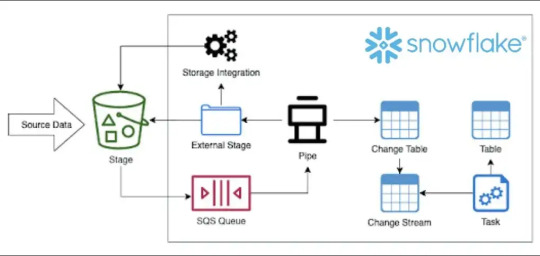Don't wanna be here? Send us removal request.
Text
Why Should You Migrate Database SQL Server to Snowflake
The focus of today’s data-driven business ecosystem is to a great extent on formatting, processing, and analyzing terabyte volumes of data, both from within the organization and externally. Hence, the goal is not only to ensure efficiency but also to operate the databases at minimum costs. One of the best ways to do so is to move databases from traditional in-house systems to the cloud. A method that is very favored among users is migrating databases from SQL Server to Snowflake.

The point now is why Snowflake and what does this cloud-based data warehousing solution bring to the table? It is primarily because soon after its launch, Snowflake was able to solve a whole lot of problems that the then databases faced. This aspect along with the many benefits of this cloud-based platform makes organizations want to shift their databases from SQL Server to Snowflake.
Here are some of the benefits of Snowflake.
· A wide range of cloud vendors is supported by Snowflake as its architecture is compatible with them. Hence, users do not have to use separate tools to work in one or all of them.
· In traditional databases, computing and storage facilities were in one silo, making it very difficult to estimate the cost of operating any one of them. In Snowflake, they are maintained separately, and hence, it is very easy to estimate the costs of operations of any one of them individually. Further, users can seamlessly scale up and down in data storage facilities by paying only for the quantum of resources used. When compared to previous databases that charged flat fees, this aspect is a huge cost-saving option and a motivation for wanting to move databases from SQL Server to Snowflake.
· Apart from unlimited storage space, Snowflake offers high computing powers. Users do not face any drop in speeds or performance lag even when multiple users carry out several intricate queries simultaneously. This, coupled with storage-on-call make Snowflake a popular data warehousing option.
· A critical benefit provided by Snowflake and a reason for organizations to migrate databases from SQL Server to Snowflake is that data in any form can be stored in this data warehousing platform. It includes data in its native format – unstructured, semi-structured, or structured – an attribute that is not present in other databases. Snowflake also offers built-in support to JSON, Parquet, Avro, and XML data.
· A major advantage of Snowflake is that the platform provides support for clustering data and there is no need for defining indexes. Some tasks like computing and encoding of columns are carried out automatically. However, users have to manually use the clustering keys of Snowflake to co-locate table data of very large tables.
These are reasons why this data warehousing solution encourages businesses to migrate databases from SQL Server to Snowflake.
4 notes
·
View notes
Text
Optimizing Business Efficiencies with the Snowflake Data Lake
There are several uses of cloud-based data platforms as well as functions that complement each other. Before going into the what is Snowflake Data Lake, a word on the concept of data lakes will be in order.
A data lake is a storage repository for data that can not only hold massive volumes of native data but is a highly scalable platform too. The advantage here is that a data lake is capable of storing data in any form – unstructured, semi-structured, and structured – without being processed and can be queried whenever required. Data lakes are critically important for organizations that have to store huge volumes of data in whatever format without the need for generating analytics right away.
Snowflake provides businesses with a fully secured and high-performing platform that has all the functionalities of a data lake as well as a data warehouse. Have Snowflake Data Lake as the primary storage repositor for high performance and governance. Alternately, you can use the Snowflake datawarehouse to store data in AWS S3, Google Cloud Storage, or Microsoft Azure and speed up analytics and data transformation with Snowflake.

Benefits of Snowflake Data Lake
Since Snowflake Data Lake is a cloud-based multi-cluster platform, it meets all the needs of the current data-driven business environment. Used by most organizations around the world, Snowflake Data Lake is a single source of all data analytics requirements and a high-performing platform, both in terms of computing powers and data storage.
Here are some of the benefits of Snowflake Data Lake.
· The Snowflake Data Lake is so structured that it can hold all types of data in their native format including unstructured, semi-structured, and structured data like CSV, Parquet, JSON, and tables.
· The data lake is a high-performing one and multiple users can simultaneously execute multiple queries without facing any lag or drop in system speeds and performance.
· Snowflake data lake is highly flexible and elastic and users have access to unlimited computing resources. The volumes of data used change dynamically in real-time and the computing engine scales in and out automatically. Running queries during these times is not affected.
· A critical benefit of the data lake is that it is available as a fully-managed service. The data management functionalities include data protection, data performance tuning, and data security and DBAs do not have to worry about these aspects at their level. Hence, Snowflake data lake has all the attributes that are expected from a cloud-based platform.
· The data lake also offers a cost-effective storage option that is without any limits. After paying the base price for data storage as charged by Google Cloud Platform, Microsoft Azure, and AWS S3, users can scale up or down in data storage by paying only for the quantum of resources used.
These are some of the many highly-optimized benefits of Snowflake data lake.
0 notes
Text
Migrating Database Oracle to Amazon S3
Amazon Simple Storage Service (S3) provides unlimited storage service that is cost-effective and lies at the core of data lakes in Amazon Web Service (AWS). A popular source for data lakes is the Amazon RDS (Relational Database Service) for Oracle databases.
For migrating databases from Oracle to S3, users need to follow certain procedures. The first is the existence of an AWS account. Next, an Amazon RDS for Oracle database and an S3 bucket must be in the same region where the AWS DMS (Database Migration Service) replication instance is created for migration.

To know more about Oracle to S3, click here.
Before the Oracle to S3 migration process is started, users have to go through the following steps.
· Prepare for replication the source Amazon RDS for Oracle database
· Create an AWS Identity and Access Management (IAM) role for getting access to the S3 bucket.
· Create a full load task as well as AWS DMS instance and endpoints.
· Create a task that takes care of CDC (Change Data Capture)
Make sure before the Oracle to S3 database migration to use Amazon RDS for Oracle as the source, both in the same Region and the target S3 bucket.
Migrate database Oracle to S3
There are two ways to migrate data from Oracle to S3 and the one chosen by an organization depends upon its specific needs.
· Importing data, Oracle Data Pump, and Database Link – Here, the Oracle Data Pump along with the Oracle DBMS_FILE_TRANSFER package are used to connect to a source Oracle instance. It can either be through an Amazon RDS for Oracle database instance or an Amazon EC2 instance. The Oracle data is exported to a dump file with the DBMS_DATAPUMP package. This file is then copied to the Amazon RDS Oracle DB instance through a connected database link. Lastly, the data is imported to S3 through the DBMS_DATAPUMP package.
· Importing Data, Oracle Data Pump, and Amazon S3 Bucket – The Oracle source data is exported using the Oracle DBMS_DATAPUMP package and the file is dumped in an Amazon S3 bucket. This file is downloaded to the DATA_PUMP_DIR directory in the RDS Oracle DB instance. Finally, the data in the dump file is imported and copied to the Amazon RDS Oracle DB instance using the DBMS_DATAPUMP package.
The goal of Oracle to S3 is to make sure that Oracle Databases can be optimized on the Amazon S3 platform. Here too, users can make use of any of the two methods as per their convenience.
The first is to run EC2 compute instances and Elastic Block Store (EBS) storage on the Oracle in-premises databases. However, this method might get complex as the entire servers and the storage infrastructure have to be replaced with that of Amazon Web Service.
The second is to shift the on-premises database Oracle to Amazon RDS which is the most popular managed database service for the most-used platforms including Oracle.
0 notes
Text
Why Should You Migrate Databases from SQL Server to S3
In the modern data-driven business environment, organizations have to constantly look for opportunities to optimize their operating and IT infrastructure capabilities. Enterprises that run critical and voluminous workloads find it beneficial to migrate to the cloud to get the benefits of advanced and cutting-edge technologies. If you are operating on in-premises Microsoft SQL Server databases, you can do so while retaining the same database engine as homogeneous migration.
What makes database migration from Microsoft SQL Server to S3 (Amazon Simple Storage Service) easy is that during the process, the source database remains fully functional. This is a big help for large businesses as shutting down systemsis a huge inconvenience.

The solutions available for migrating databases from SQL Server to S3 that entail migrating from an on-premises environment to the cloud are not complex and most are fully automated. The backup and restore method of SQL Server is used in conjunction with Amazon Web Service Database Migration Service for migrating database code objects such as storing procedures, functions, and views.
The tools used for SQL Server to S3 migration apply to SQL Server databases of all volumes. They are also applicable when there is a need to validate the target database during data replication from the source to the target, thereby saving time on validating data. The only limitation is that this type of solution can only be used when there are no restrictions on using SQL Server as a source for AWS DMS.
Why do organizations prefer to migrate data from SQL Server to S3?
First, and most critical, is that S3 provides unmatched data scalability and durability. This is primarily because, being cloud-based, S3 offers limitless storage facilities and businesses can get large projects up and running immediately without having to invest in additional hardware and software. Further, migrating to S3 provides access to high-performance computing powers. Multiple users can work simultaneously on multiple intricate queries without any drop in speeds.
Other advantages of the cloud are available to businesses after migrating from SQL Server to S3. These include cost affordability, access management, data protection, and data replication functions. The database replication process can be done both inside and outside the region with S3 having the powers to go through billions of objects of Batch Operations.
Before migrating databases from SQL Server to S3 certain conditions need to be fulfilled. The AWS account used for migration must have an IAM role. The DMS replication instance for data migration and the S3 bucket that is the target database should be in the same region. Finally, there should be tagging access in the role to ensure that objects that are written to the target bucket can be tagged via AWS CDC S3.
The user completing the migration task must have necessary permissions for it.
0 notes
Text
2K notes
·
View notes

